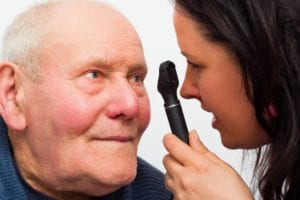Written by Greg Arnold, DC, CSCS. Supplementation with three carotinoids, lutein, zeaxanthin, and mesozeaxanthin, for 12 months significantly improve macular pigment ocular density, decrease glare severity, and improved photostress recovery time in study participants.
 Carotenoids are the antioxidants that give vegetables their color and are extremely valuable to helping maintain optimal health. Three specific carotenoids are abundant in the eye and have been shown to be crucial to eye health: lutein, zeaxanthin, and mesozeaxanthin 1, of which mesozeaxanthin is the strongest 2. A 2013 study 3 concluded that these three carotenoids “could prolong the onset or delay the progression” of an eye disease called age-related macular degeneration.
Carotenoids are the antioxidants that give vegetables their color and are extremely valuable to helping maintain optimal health. Three specific carotenoids are abundant in the eye and have been shown to be crucial to eye health: lutein, zeaxanthin, and mesozeaxanthin 1, of which mesozeaxanthin is the strongest 2. A 2013 study 3 concluded that these three carotenoids “could prolong the onset or delay the progression” of an eye disease called age-related macular degeneration.
More recent research also suggests that these three carotenoids may also benefit other aspects of eye health. In a 2016 study 4, 59 healthy subjects (27 men, 32 women) between the ages of 20 and 22 were grouped into one of the following groups for 12 months:
- 10 mg lutein + 2 milligrams total zeaxanthin (1 mg zeaxanthin + 1 mg mesozeaxanthin = 24 subjects)
- 20 mg lutein + 4 mg total zeaxanthin (2 mg zeaxanthin + 2 mg mesozeaxanthin = 25 subjects),
- Placebo group = 10 subjects
Before and after the study, each subject was tested for various measure of eye health.
The researchers noted statistically significant benefits in the carotenoid group regarding:
- Macular Pigment Optical Density (MPOD) (with increased readings showing an improved state of eye health)
- Disability Glare (DG) (with an increased reading showing a decreased glare severity)
- Photostress recovery (PSR) (a measure of fatigue, with decreased readings showing an improvement in eye health):
12 mg (n=24) p – value 0-12 months 24 mg (n=25) p – value 0-12 months Placebo (n=10) p-value
MPOD 34% increase (0.488 to 0.654) < 0.05 34% increase (0.511 to 0.685) < 0.05 7% increase (0.527 to 0.564) > 0.05
DG 40% increase (86.02 to 120.43) < 0.05 40% increase (91.8 to 128.52) < 0.05 4% increase (88.42 to 91.96) > 0.05
(PSR mins) 24.1% decrease (9.11 to 6.92) < 0.05 25.1% decrease (9.33 to 6.99) < 0.05 0.8% decrease (8.78 to 8.71) > 0.05
For the researchers, they found a direct correlation between improve optical density with glare severity and photostress recovery, and suggest that “the mechanisms for the effects of density glare and photo stress recovery may be derived from different characteristics of macular pigment (MP), they may involve both or either the optical filtering and biochemical (antioxidant) properties of MP”.
Source: Stringham, James M., Kevin J. O’Brien, and Nicole T. Stringham. “Macular carotenoid supplementation improves disability glare performance and dynamics of photostress recovery.” Eye and Vision 3, no. 1 (2016): 30.
© Creative Commons Attribution 4.0 International License (http://creativecommons.org/licenses/by/4.0/),(http://creativecommons.org/publicdomain/zero/1.0/)
Greg Arnold is a Chiropractic Physician practicing in Hauppauge, NY. You can contact Dr. Arnold directly by emailing him at PitchingDoc@msn.com or visiting his web site at www.PitchingDoc.com
References:
- Bone RA, Landrum JT, Friedes LM, et al. Distribution of lutein and zeaxanthin stereoisomers in the human retina. Experimental eye research. 1997;64(2):211-218.
- Bhosale P, Bernstein PS. Synergistic effects of zeaxanthin and its binding protein in the prevention of lipid membrane oxidation. Biochimica et Biophysica Acta (BBA)-Molecular Basis of Disease. 2005;1740(2):116-121.
- Chew EY, Clemons TE, SanGiovanni JP, et al. Lutein+ zeaxanthin and omega-3 fatty acids for age-related macular degeneration: the Age-Related Eye Disease Study 2 (AREDS2) randomized clinical trial. JAMA-Journal of the American Medical Association. 2013;309(19):2005-2015.
- Stringham JM, O’Brien KJ, Stringham NT. Macular carotenoid supplementation improves disability glare performance and dynamics of photostress recovery. Eye and Vision. 2016;3(1):30.
